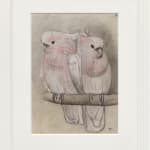Theo van Hoytema (1863-1917)
Theo van Hoytema, born in The Hague as the youngest of seven siblings, was orphaned at a young age. Nevertheless, he pursued a career as an artist. By 1890, Hoytema had established a studio near Castle De Brinckhorst, on the outskirt of The Hague. The Dutch tradition of reverence for the natural world surely contributed to Hoytema’s early success. Like many of his contemporaries, he found inspiration at Amsterdam’s renowned zoo Artis. Flora and fauna occupied his artistic output, which spanned paintings, drawings, graphic work, and applied arts. His work reflects the influence of English illustrators like Walter Crane, Japanese woodblock prints, and the stylized aesthetics of Art Nouveau, prevalent at the turn of the twentieth century.
Hoytema organized his sketches and drawings into portfolios sorted by subject, covering a period of three decades.[1] Rarely did he sign or date drawings, making it challenging to establish a clear chronology. Despite suffering from chronic illness and depression, Hoytema remained productive, even during his hospitalization in 1904 and 1905. In 1900, over seventy works were auctioned at Frederik Muller & Cie in Amsterdam, possibly to provide financial support for the ailing artist.[2] When Hoytema died in 1917, he ensured that most of his works were preserved in public collections, at the Kunstmuseum in The Hague and the Rijksmuseum in Amsterdam, while over 100 drawings were sold at auction.
Hoytema’s affection for the animal kingdom, often portrayed as whimsical characters defines his legacy. Birds held a special place in his work, as noted by art critic Jan Veth in the introduction to the 1900 auction. His first lithographed booklet Hoe de vogels aan hun koning kwamen (How the Birds Found Their King) from 1892 was dedicated to his feathered friends. That same year, Hoytema gained widespread acclaim for his illustrations of Hans Christian Andersen’s fairy tale The Ugly Duckling, followed by other bird-themed picture books. Although primarily known for his calendars, graphic work, and decorative arts, Hoytema occasionally turned to larger-scale painting. His monumental The Return of the Stork, now in Museum Boijmans Van Beuningen, is a testament to his ability to bring the natural world to life in any medium.
[1] Marjan Boot, Theo van Hoytema 1863-1917, Zwolle 1999, pp. 97-117
[2] Sale, Werk van Th. Van Hoytema, Frederik Muller & Cie, Amsterdam, 24 April 1900
Provenance
Mak van Waay, Amsterdam, December 2002, lot 332Private collection, The Netherlands
Onder de Boompjes, Leiden, 19 June 2023, lot 93



